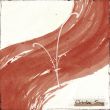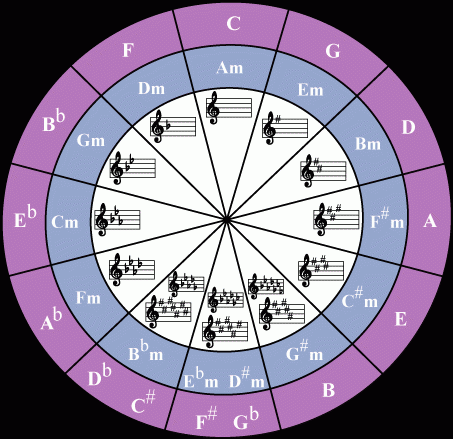| Empirism |
|
29 Jul 2008 14:20 | Quote |
Joined: 23 Jun 2008 Finland  Lessons: 4 Karma: 35 
|
Found this interesting and ive seen it requested on lessons, but didnt find any?
What it is and if you know good... should I say as simple as possible link to get in to it...
Thanks
Edit, ive founded one post too in forum, but im too old dog that it just didnt revealed yet :) |
| Phip |
|
29 Jul 2008 18:29 | Quote |
Joined: 23 Dec 2007 United States  Lessons: 1 Karma: 45  Moderator Moderator
|
"Circle of fifths"
sounds like a drinking game! |
| brodyxhollow |
|
29 Jul 2008 19:26 | Quote |
Joined: 04 Feb 2008 United States  Karma Karma: 2 
|
actually, its a reference to the fact that every fifth has a fifth, and eventually if you follow this "circle of fifths" it will come back to the original fifth.
ill do some research on it and find the chart for it. just imagine a clock where you skip from 12(A) to 5(E), 5(E) to 11(B), 11(B) to 4(F#), 4(F#) to 9(C#), etc... my math might be bad, but you get the idea. but it goes back to where it started. |
| blackholesun |
|
30 Jul 2008 04:37 | Quote |
Joined: 04 Jan 2007 United Kingdom  Licks: 1 Karma: 11  Moderator Moderator
|
And as you go around the clock, the number of sharps in each key increases. C (no sharps), G (1 - F#), D (2 - F# and C#), A (3 - F#, C# and G#) and so on.
If you go the other way round the clock (in 4ths if you like), the number of flats in each key increases. C (no flats), F (1 - Bb), Bb (2 - Bb and Eb), and so on. |
| Doz |
|
30 Jul 2008 04:40 | Quote |
Joined: way back United Kingdom  Karma Karma: 10 
|
Yeah, like brody said. You can draw one yourself as many times as you want so that you remember it. In a major key it starts on C, and then you count a fifth from it (including the note your on and the note you land on). So the next note is G.
C D E F G
^ ^
1 2 3 4 5
Then you do it the same until you've filled the clockface. To do it for minor keys start with A at the top. You can then use this drawing as a referance chart - and it helps you to see how many sharps and flats are in each key. Starting with no flats in the key of Cmajor going down the left side you add one flat for each.
C F Bb Eb Ab Db Gb/F# - keys on the left side
0 1 2 3 4 5 6 - number of flats
Down the right side, you add sharps.
C G D A E B Gb/F# - keys on the right side
0 1 2 3 4 5 6 - number of sharps
It's also useful tool for transposing to different keys. If you look at C, G and A and imagine it as a chord progression in the key of C - to get the same progression in the key of A it'd be A, E and F#.
Yeah, it's possible to do that without the image but for beginners it helps visualise the change better and it makes sense more. |
| blackholesun |
|
30 Jul 2008 05:04 | Quote |
Joined: 04 Jan 2007 United Kingdom  Licks: 1 Karma: 11  Moderator Moderator
|
|
| blackholesun |
|
30 Jul 2008 05:05 | Quote |
Joined: 04 Jan 2007 United Kingdom  Licks: 1 Karma: 11  Moderator Moderator
|
The purple outer ring is the major key, and the blue inner ring is the relative minor. |
| Doz |
|
30 Jul 2008 05:33 | Quote |
Joined: way back United Kingdom  Karma Karma: 10 
|
Oh... I forgot to include the actually image - but yeah... |
| Empirism |
|
30 Jul 2008 07:38 | Quote |
Joined: 23 Jun 2008 Finland  Lessons: 4 Karma: 35 
|
Interesting, helps a lot for composing. thanks to all. Ill start to try memorize it :P |
| les_paul |
|
30 Jul 2008 16:13 | Quote |
Joined: 14 Feb 2008 United States  Lessons: 3 Licks: 2 Karma: 11 
|
If you go to this lesson at UG it talks about the circle of fifths.
http://www.ultimate-guitar.com/lessons/for_beginners/learning_music_theory_the_beginning.html
Also a lot of other good stuff but the circle of fifths is in section 5. |
| Doz |
|
30 Jul 2008 16:35 | Quote |
Joined: way back United Kingdom  Karma Karma: 10 
|
Ah yes, that UG lesson is really good. |
| KicknGuitar |
|
|
Joined: 13 Dec 2007 Lessons: 6 Karma: 1 
|
Empirism,
Try taking Major fifth first (outside circle) then tackle the inside circle.
Another easy way is to break that down to four groups,
Sharp Majors, Flat Majors, Sharp Minors, Flat Minors.
After memorizing the key (number of accidentals), work on understanding how the majors and minors intertwine.
If you're looking to compose and understand all the notes... try to memorize every note for each key,
G A B C D E F# G
D E F# G A B C# D
A B C# D E F# G# A
And so on...
|
| Admin |
|
12 Aug 2008 17:07 | Quote |
Joined: way back Latvia  Lessons: 2 Licks: 1 Karma: 27 
|
|
| Crunch |
|
12 Aug 2008 19:41 | Quote |
Joined: 31 Jul 2007 United States  Karma Karma: 3 
|
Admin-if you did that yourself, (which the copyright leads me to believe) well done, and if not, thanks anyway :) |
| brodyxhollow |
|
13 Aug 2008 06:20 | Quote |
Joined: 04 Feb 2008 United States  Karma Karma: 2 
|
our admin is amazing. |
| Empirism |
|
13 Aug 2008 12:47 | Quote |
Joined: 23 Jun 2008 Finland  Lessons: 4 Karma: 35 
|
Nice! Im still workin on this and now its more easier, thanks! |
| marsdemartini |
|
13 Aug 2008 13:44 | Quote |
Joined: 15 May 2008 United States  Karma Karma: 1 
|
want something more than fifths... how about 12
http://www.ronjarzombek.com/rj12tone.html |
| mars335x |
|
26 Oct 2008 13:31 | Quote |
Joined: 23 Oct 2008 United States  Karma Karma 
|
the UG lesson is super long but it clears alot up |
|
|
















